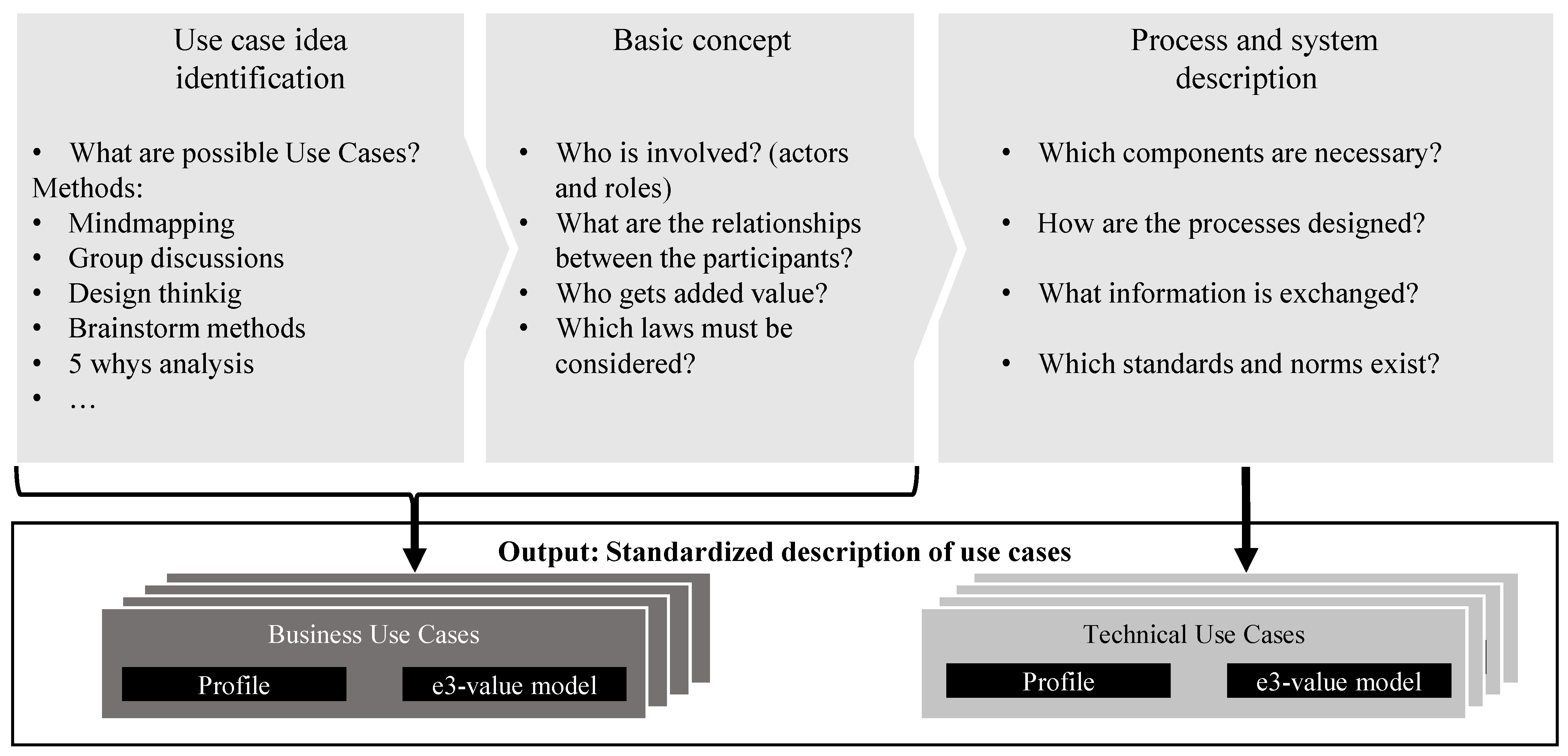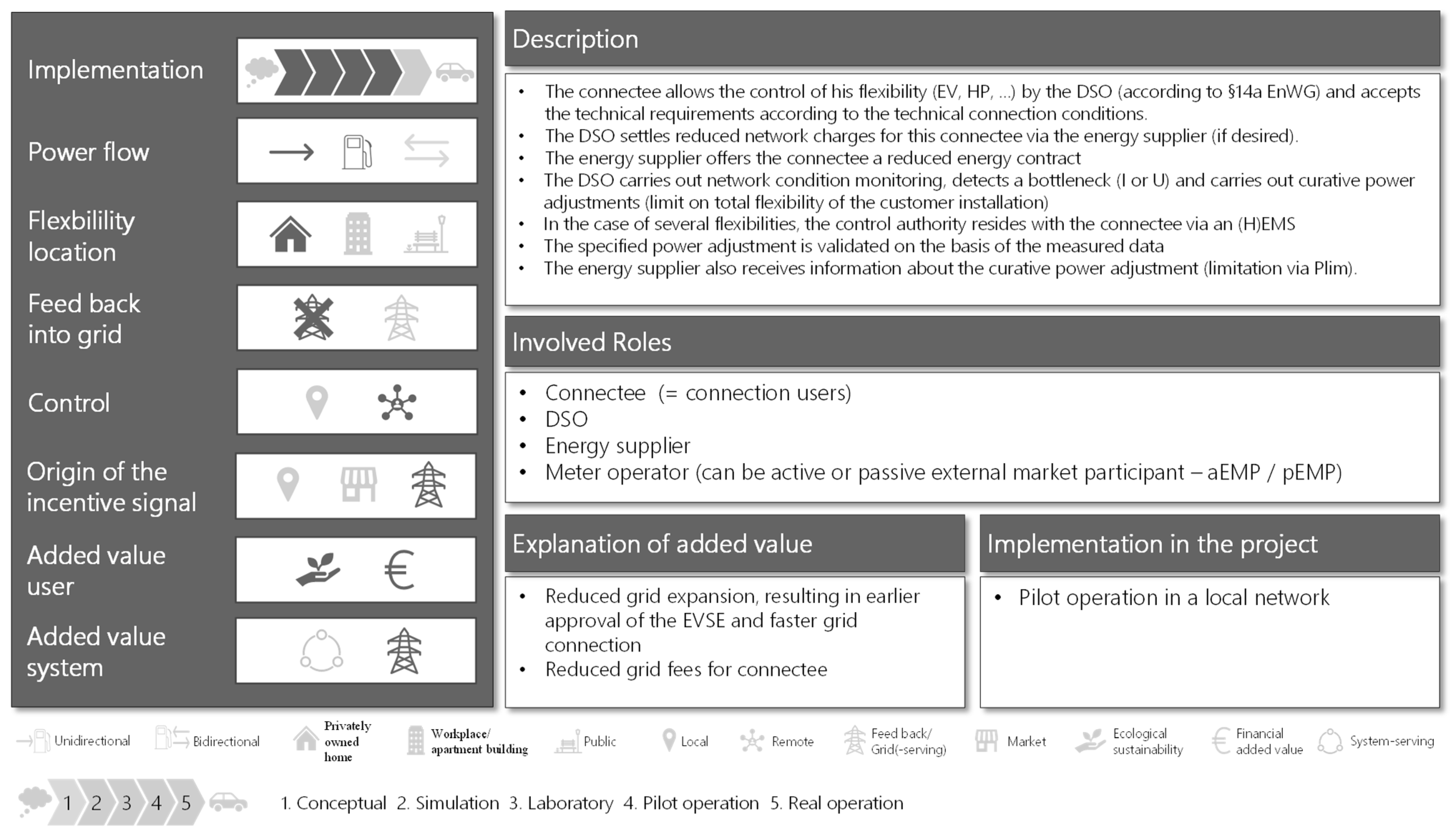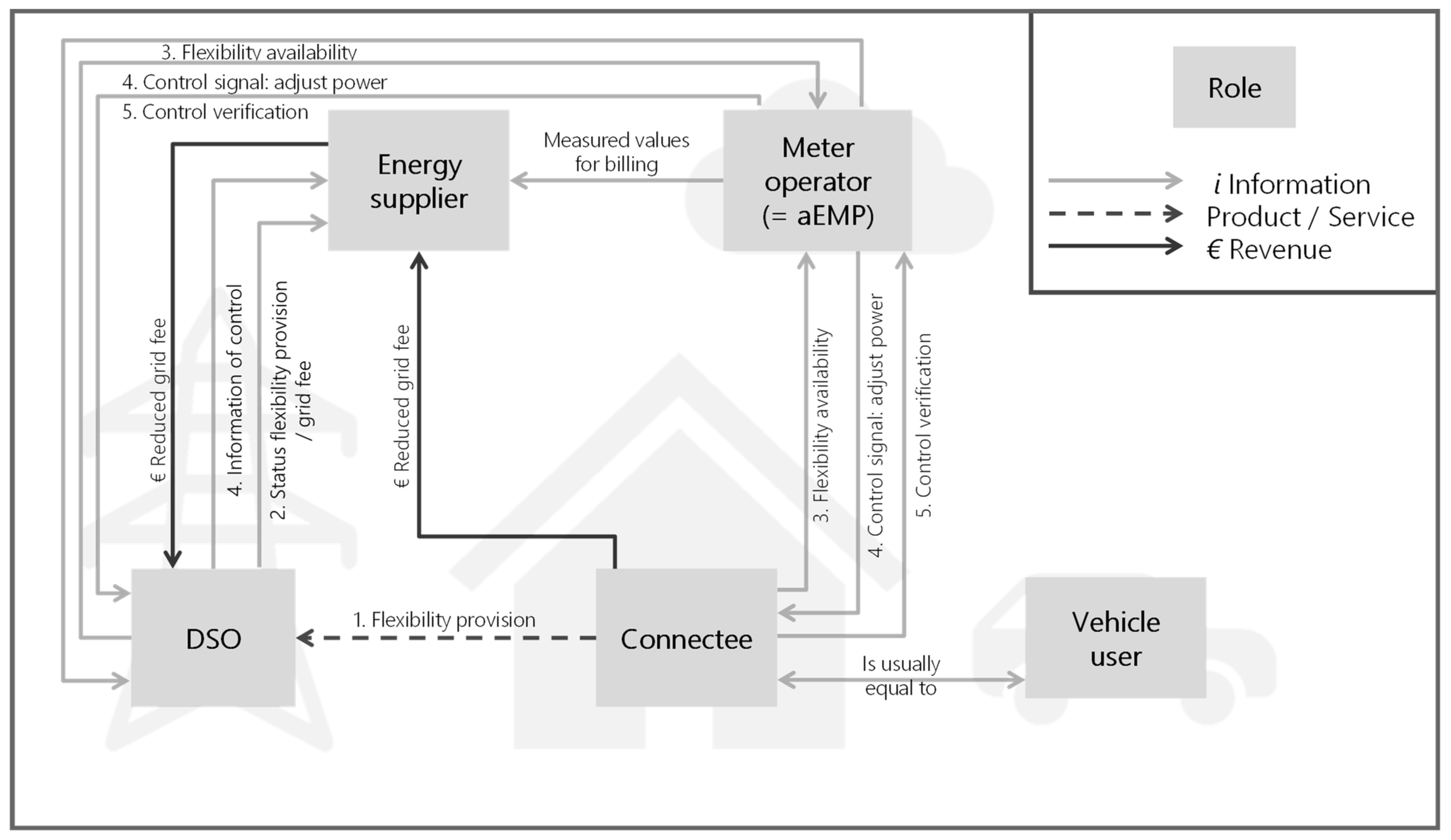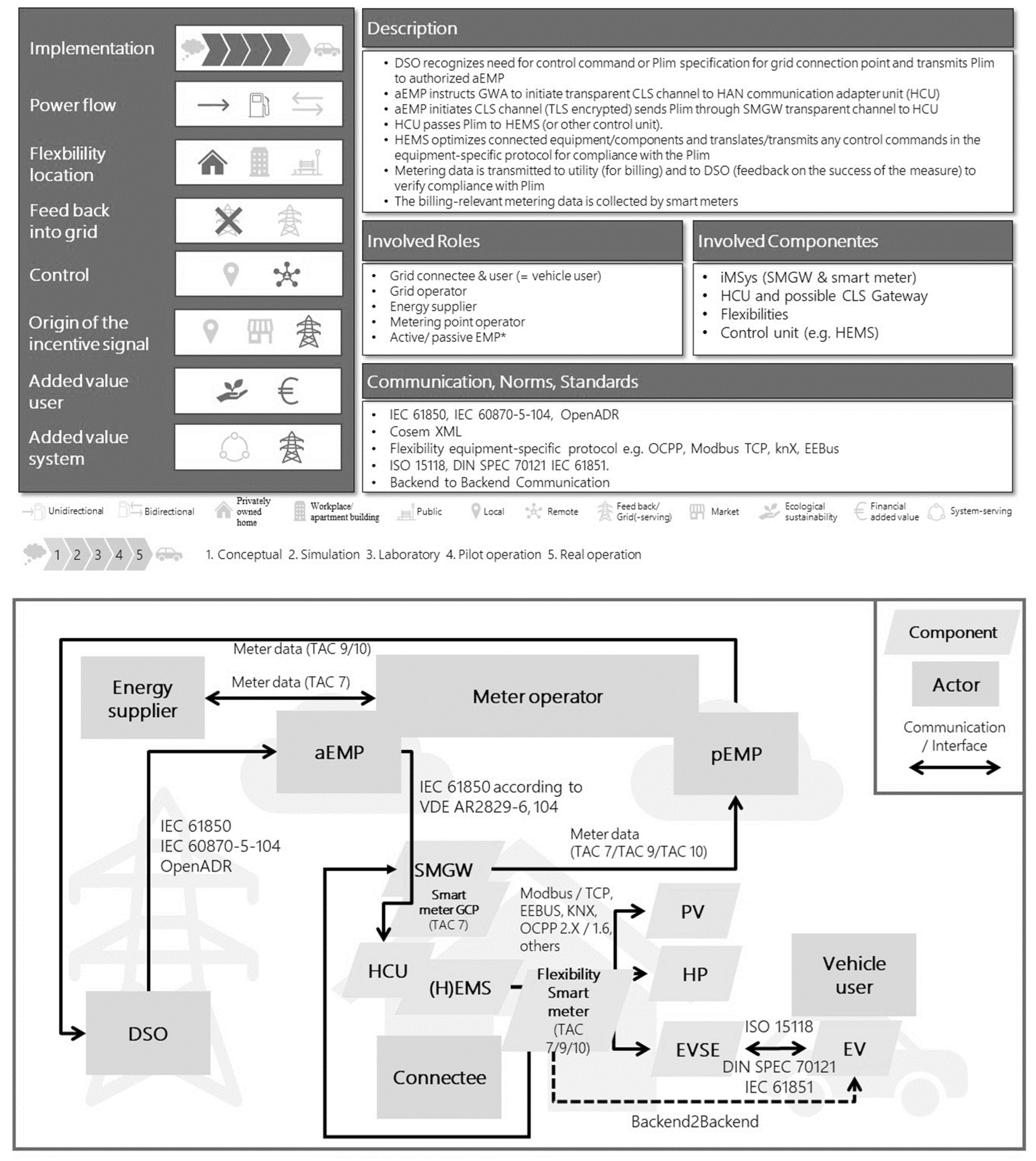Design and Application of the unIT-e2 Project Use Case Methodology
Abstract
1. Introduction
2. The Project unIT-e2, German Market and Regulations
3. unIT-e2 Use-Case Methodology
3.1. Literature Review
3.2. Methodology Description
4. Resulting Business Use Cases in unIT-e2
4.1. Incentive Signal: Local/On Site
4.2. Incentive Signal: Electricity Market
4.3. Incentive Signal: Grid/System
5. Business Use Case: Regulatory-Defined Grid-Serving Flexibility
6. Technical Use Case: Regulatory-Defined Grid-Serving Flexibility
7. Conclusions and Outlook
Author Contributions
Funding
Data Availability Statement
Acknowledgments
Conflicts of Interest
Abbreviations
| BCM | Bidirectional Charging Management |
| BUC | Business-Use Case |
| CLS | Controllable Local System |
| DSO | Distribution Network Operator |
| EMS | Energy Management System |
| EU | European Union |
| EV | Electric Vehicle |
| EVSE | Electric Vehicle Supply Equipment |
| GCP | Grid Connection Point |
| GHG | Greenhouse Gas |
| GWA | Gateway Administrator |
| HAN | Home Area Network |
| HCU | HAN Communication Adapter Unit |
| HEMS | Home Energy Management System |
| HP | Heat Pump |
| OEM | Original Equipment Manufacturer |
| SGAM | Smart Grid Architecture Model |
| SMGW | Smart Meter Gateway |
| SP | Sub Project |
| TUC | Technical-Use Case |
| UML | Unified Modeling Language |
References
- Paris Agreement; Version 2015; United Nations: Paris, France, 2015.
- EEA Greenhouse Gases-Data Viewer. Available online: https://www.eea.europa.eu/data-and-maps/data/data-viewers/greenhouse-gases-viewer (accessed on 10 February 2022).
- Bird, L.; Debra, L.; Millian, M.; Carilini, M.; Estanqiero, A.; Flynn, D.; Gomez-Lazaro, E.; Holttingen, H.; Menemenlis, N.; Orths, A.; et al. Wind and solar energy curtailment: A review of international experience. Renew. Sustain. Energy Rev. 2016, 65, 577–586. [Google Scholar] [CrossRef]
- Denholm, P.; Hand, M. Grid flexibility and storage required to achieve very high penetration of variable renewable electricity. Energy Policy 2011, 39, 1817–1830. [Google Scholar] [CrossRef]
- Bistline, J. Economic and technical challenges of flexible operations under large-scale variable renewable deployment. Energy Econ. 2017, 64, 363–372. [Google Scholar] [CrossRef]
- Guerra, K.; Haro, P.; Gutiérrez, R.; Gómez-Barea, A. Facing the high share of variable renewable energy in the power system: Flexibility and stability requirements. Appl. Energy 2022, 310, 118561. [Google Scholar] [CrossRef]
- Mathiesen, B.V.; Lund, H.; Connolly, D.; Wenzel, H.; Østergaard, P.A.; Möller, B.; Nielsen, S.; Ridjan, I.; Karnøe, P.; Sperling, K. Smart Energy Systems for coherent 100% renewable energy and transport solutions. Appl. Energy 2015, 145, 139–154. [Google Scholar] [CrossRef]
- Mathiesen, B.V.; Connolly, D.; Lund, H.; Nielsen, M.P.; Schaltz, E.; Wenzel, H.; Bentsen, N.S.; Felby, C.; Kaspersen, P.; Ridjan, I. CEESA 100% Renewable Energy Transport Scenarios towards 2050—Technical Background Report Part 2; Aalborg University: Copenhagen, Denmark, 2015. [Google Scholar]
- Duscha, V.; Wachsmuth, J.; Eckstein, J.; Pfluger, B. GHG-Neutral EU2050—A Scenario of an EU with Net-Zero Greenhouse Gas Emissions and Its Implications; Umweltbundesamt: Dessau-Roßlau, Germany, 2019. [Google Scholar]
- National Emissions Reported to the UNFCCC and to the EU Greenhouse Gas Monitoring Mechanism; European Environment Agency (EEA): Copenhagen, Denmark, 2020. Available online: https://www.eea.europa.eu/data-and-maps/data/national-emissions-reported-to-the-unfccc-and-to-the-eu-greenhouse-gas-monitoring-mechanism-16 (accessed on 27 February 2022).
- Bieker, G. A Global Comparison of the Life Cycle Greenhouse Gas Emissions of Combustion Engine and Electic Passenger Cars; The International Council on Clean Transportation: Berlin, Germany, 2021. [Google Scholar]
- Dornoff, J.; Mock, P.; Baldino, C.; Bieker, G.; Díaz, S.; Miller, J.; Sen, A.; Tietge, U.; Wappelhorst, S. Fit for 55: A Review and Evaluation of the European Commission Proposal for Amending the CO2 Targets for New Cars and Vans; The International Council on Clean Transportation: Berlin, Germany, 2021. [Google Scholar]
- Total Market Share of Newly Registered Passenger Electric Vehicles in the European Union between 2015 and 2020. Available online: https://www.statista.com/statistics/625010/electric-vehicle-market-share-in-eu-annual/ (accessed on 20 May 2022).
- Volkswagen Naturstrom. Available online: https://www.elli.eco/en/green-energy (accessed on 9 May 2022).
- Tesla Stromtarif. Available online: https://www.tesla.com/de_de/tesla-stromtarif (accessed on 9 May 2022).
- Verordnung über Allgemeine Bedingungen für den Netzanschluss und dessen Nutzung für die Elektrizitätsversorgung in Niederspannung (Niederspannungsanschlussverordnung—NAV); Bundesrepublik Deutschland: Berlin, Germany, 2006.
- Project Webpage unIT-e²: Living Lab for Integrated e-Mobility. Available online: https://unit-e2.de/ (accessed on 29 August 2022).
- Gesetz über Die Elektrizitäts- und Gasversorgung (Energiewirtschaftsgesetz) (EnWG); Version 2018; Bundesministerium der Justiz und für Verbraucherschutz: Berlin, Germany, 2018.
- European Commission v Federal Republic of Germany. Failure of a Member State to fulfil Obligations—Internal Markets for Electricity and Natural Gas (Case C-718/18); Court of Justice of the European Union: Luxembourg, 2021. [Google Scholar]
- Pressemittelung zur Berichterstattung in der Heutigen Welt am Sonntag zu Thema Laden von E-Autos. Available online: https://www.bmwk.de/Redaktion/DE/Pressemitteilungen/2021/01/20210117-berichterstattung-welt-am-sonntag-laden-von-e-autos.html (accessed on 9 May 2022).
- Gesetz zur Digitalisierung der Energiewende; Version 2016; Bundesministerium für Wirtschaft und Energie (BMWi): Bonn, Germany, 2016.
- Ziemsky, V.; Biedenbach, F.; Matzner, A. Systemintegration von Elektrofahrzeugen—Stromlieferverträge mit Nicht-Statischen Tarifen-FfE Grundlagenpapier; Forschungsstelle für Energiewirtschaft (FfE): München, Germany, 2022. [Google Scholar]
- Stufenmodell zur Weiterentwicklung der Standards für Die Digitalisierung der Energiewende; Bundesamt für Sicherheit in der Informationstechnik: Berlin, Germany; Bundesministerum für Wirtschaft und Energie: Bonn, Germany, 2020.
- Müller, M.; Biedenbach, F.; Reinhard, J. Development of an Integrated Simulation Model for Load and Mobility Profiles of Private Households. Energies 2020, 13, 3843. [Google Scholar] [CrossRef]
- Doppelter Haushaltsstromverbrauch mit Elektroauto. Available online: https://www.vbew.de/energie/presseinfos-energie/news/doppelter-haushaltsstromverbrauch-mit-elektroauto (accessed on 11 May 2022).
- Cockburn, Alistair: Writing Effective Use Cases; Addison-Wesley Professional: Boston, MA, USA, 2000.
- IEC SRD 62913-1:2019; Generic Smart Grid Requirements (Part 1: Specific Application of the Use Case Methodology for Defining Generic Smart Grid Requirements According to the IEC Systems Approach). International Electrotechnical Commission: Geneva, Switzerland, 2019.
- Oestereich, B. Analyse und Design Mit der UML 2.5—Objektorientierte Softwareentwicklung; Oestereich: München, Germany, 2012. [Google Scholar]
- IEC 62559-2:2015; Use Case Methodology—Part 2: Definition of the Templates for Use Cases, Actor List and Requirements List. Issued 2015-04; International Electrotechnical Commission: Geneva, Switzerland, 2015.
- Gordijn, J.; Akkermans, J.M. Value-based requirements engineering exploring innovative e-commerce ideas. Requir. Eng. 2003, 8, 114–134. [Google Scholar] [CrossRef]
- CEN-CENELEC-ETSI. Smart Grid Coordination Group: SG-CG/M490/K_ SGAM Usage and Examples—SGAM User Manual—Applying, Testing & Refining the Smart Grid Architecture Model (SGAM); Version 3.0; CENELEC: Brüssel, Belgien, 2014. [Google Scholar]
- Faller, S.; Bogensperger, A.; Köppl, S.; Kießling, A. Anwendungshilfe Use Case Methodik—Eine praktische Anwendungshilfe für die Use Case Entwicklung; Forschungsstelle für Energiewirtschaft e. V. (FfE): München, Germany, 2020. [Google Scholar]
- Weigand, H.; Johannesson, P.; Andersson, B.; Bergholtz, M.; Edirisuriya, A.; Ilayperuma, T.; Ribbers, P. Strategic analysis using value modeling—The c3-value approach. In Proceedings of the 40th Hawaii International Conference on System Sciences, Waikoloa, HI, USA, 3–6 January 2007; Tilburg University: Tilburg, The Netherlands, 2007. [Google Scholar]
- IEC 62559—Use Case Methodology. Available online: https://syc-se.iec.ch/deliveries/iec-62559-use-cases/ (accessed on 9 May 2022).
- CEN-CENELEC-ETSI. Smart Grid Coordination Group: SG-CG/M490/I_Smart Grid Interoperability—Methodologies to Facilitate Smart Grid System Interoperability through Standardization, System Design and Testing; CEN-CENELEC-ETSI: Brüssel, Belgium, 2014. [Google Scholar]
- IEEE Standard Computer Dictionary: A Compilation of IEEE Standard Computer Glossaries; Issued 1991-01-18; IEEE: New York, NY, USA, 1991.
- Faller, S.; Schütz, J.; Bogensperger, A.; Uslar, M. Anwendungshilfe SGAM—Smart Grid Use Cases modellieren. In Energiwirtschaftliche Tagesfragen; Forschungsstelle für Energiewirtschaft e. V. (FfE), OFFIS e.V.: Offenbach, Germany, 2020. [Google Scholar]
- CEN-CENELEC-ETSI. Smart Grid Coordination Group: SG-CG/ M490/F_ Overview of SG-CG Methodologies; CENELEC: Brüssel, Belgien, 2014. [Google Scholar]
- Frein, C. Rollenmodell für Die Marktkommunikation im Deutschen Energiemarkt—Anwendungshilfen—Strom und Gas; BDEW Bundesverband der Energie- und Wasserwirtschaft e.V.: Berlin, Germany, 2016. [Google Scholar]
- ENTSO-E. The Harmonised Electricity Market Role Model; entso-e aisbl: Brüssel, Belgien, 2017. [Google Scholar]
- EASEE-Gas. Harmonised Gas Role Model Specification; EASEE-Gas: Paris, France, 2016. [Google Scholar]
- Business Process Model and Notation (BPMN); Object Management Group: Needham, MA, USA, 2011.
- InDEED—Konzeption, Umsetzung und Evaluation einer auf Blockchain Basierenden Energiewirtschaftlichen Datenplattform für die Anwendungsfälle “Labeling” und “Asset Logging”. Available online: https://www.ffe.de/projekte/indeed/ (accessed on 11 May 2022).
- Trade-EVs II—Trade of Renewable, Aggregated and Distributed Energy by Electric Vehicles. Available online: www.ffe.de/tradeEVsII (accessed on 1 January 2021).
- Bidirektionales Lademanagement (BDL)—Intelligentes Zusammenspiel von Elektrofahrzeugen, Ladeinfrastruktur und Energiesystem. Available online: https://www.ffe.de/projekte/bdl/ (accessed on 9 January 2021).
- Schulze, Y.; Müller, M.; Faller, S.; Duschl, W. Was ist Netzdienlichkeit? In et-Energiewirtschaftliche Tagesfragen; Forschungsstelle für Energiewirtschaft (FFE e.V.): München, Germany, 2021. [Google Scholar]
- Bogensperger, A.; Estermann, T.; Samweber, F.; Köppl, S.; Müller, M.; Zeiselmair, A.; Wohlschlager, D. Smart Meter—Umfeld, Technik, Mehrwert; Forschungsstelle für Energiewirtschaft e.V.: München, Germany, 2018. [Google Scholar]
- Bundesamt für Sicherheit in der Informationstechnik (BSI). Zertifizierung nach ISO 27001 auf der Basis von IT-Grundschutz—Zertifizierungsschema; Version 1.2; Bundesamt für Sicherheit in der Informationstechnik (BSI): Bonn, Germany, 2014. [Google Scholar]
- Technische Richtlinie BSI TR-03109-1—Anforderungen an die Interoperabilität der Kommunikationseinheit Eines Intelligenten Messsystems; Version 1.1; Bundesamt für Sicherheit in der Informationstechnik: Bonn, Germnay, 2021.
- FfE Model: GridSim—Electric Grid and Energy System Model for Distribution Grids. Available online: https://www.ffe.de/en/tools/gridsim-electricity-grid-and-energy-system-model-for-distribution-grids/ (accessed on 1 December 2022).
- FfE Model: eFlame—Electric Flexibility Assessment Modeling Environment. Available online: https://www.ffe.de/tools/eflame-electric-flexibility-assessment-modeling-environment/ (accessed on 1 December 2022).






Disclaimer/Publisher’s Note: The statements, opinions and data contained in all publications are solely those of the individual author(s) and contributor(s) and not of MDPI and/or the editor(s). MDPI and/or the editor(s) disclaim responsibility for any injury to people or property resulting from any ideas, methods, instructions or products referred to in the content. |
© 2023 by the authors. Licensee MDPI, Basel, Switzerland. This article is an open access article distributed under the terms and conditions of the Creative Commons Attribution (CC BY) license (https://creativecommons.org/licenses/by/4.0/).
Share and Cite
Ostermann, A.; Vollmuth, P.; Ziemsky, V. Design and Application of the unIT-e2 Project Use Case Methodology. World Electr. Veh. J. 2023, 14, 13. https://doi.org/10.3390/wevj14010013
Ostermann A, Vollmuth P, Ziemsky V. Design and Application of the unIT-e2 Project Use Case Methodology. World Electric Vehicle Journal. 2023; 14(1):13. https://doi.org/10.3390/wevj14010013
Chicago/Turabian StyleOstermann, Adrian, Patrick Vollmuth, and Valerie Ziemsky. 2023. "Design and Application of the unIT-e2 Project Use Case Methodology" World Electric Vehicle Journal 14, no. 1: 13. https://doi.org/10.3390/wevj14010013
APA StyleOstermann, A., Vollmuth, P., & Ziemsky, V. (2023). Design and Application of the unIT-e2 Project Use Case Methodology. World Electric Vehicle Journal, 14(1), 13. https://doi.org/10.3390/wevj14010013





